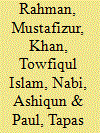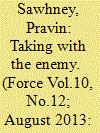|
|
|
Sort Order |
|
|
|
Items / Page
|
|
|
|
|
|
|
| Srl | Item |
| 1 |
ID:
103949


|
|
|
|
|
| Publication |
2011.
|
| Summary/Abstract |
This article investigates new opportunities that are emerging for Bangladesh with regard to her trade with India. In spite of the growing bilateral trade deficit, value of Bangladesh’s exports to India increased by about three times over the last five years. Examination of the dynamics of Bangladesh–India bilateral trade reveals that the number of products in Bangladesh’s export basket has registered significant increase, while at the same time, composition of the country’s exports to India has also shifted towards newer and non-traditional products. RCA analysis shows that export items with RCA > 1 in India, which include raw jute, chemical fertilizer, cement, RMG, leather, battery, textile fabrics and some other items, have significant export opportunities and have a combined potential market of US$ 2 billion in India. On the basis of examination of various tariff and nontariff barriers to trade with India, the article attempts to assess the economic implications of India’s sensitive list as it applies to Bangladesh, and argues that elimination of this list is not likely to have an adverse impact on India’s revenue earnings. The article also comes up with a number of recommendations to deal with the NTBs faced by Bangladesh in her trade with India, particularly in areas related to constraints arising from lack of trade facilitation.
|
|
|
|
|
|
|
|
|
|
|
|
|
|
|
|
| 2 |
ID:
127397


|
|
|
| 3 |
ID:
109869


|
|
|
| 4 |
ID:
126210


|
|
|
|
|
| Publication |
2013.
|
| Summary/Abstract |
Should India talk with Pakistan's chief of army staff (COAS)? While most in Delhi will dismiss this idea as asinine, the US nearly pulled this rabbit out of the hat in December 2010.
Writing in his recent book, The Dispensable Nation, Vali Nasr, who was senior advisor to Ambassador Richard Holbrooke, the US special representative for Afghanistan and Pakistan, says that "Holbrooke had persuaded General Kayani to agree in principle to talks with India over Afghanistan and Afghanistan only." With this assurance, Holbrooke met the Indian diplomat (unnamed) over dinner in the US on 6 December 2010. According to Nasr, the Indian diplomat took this message to Delhi, and "shortly thereafter, a message came from Delhi that Singh (Prime Minister Manmohan Singh) had given the green light". The meeting never took place as Holbrooke died within a week.
|
|
|
|
|
|
|
|
|
|
|
|
|
|
|
|
| 5 |
ID:
109871


|
|
|
| 6 |
ID:
126782


|
|
|
| 7 |
ID:
106046


|
|
|
|
|
| Publication |
2011.
|
| Summary/Abstract |
eginning in the late 1960s and early 1970s, the United States discussed or extended capital and technology, Most Favoured Nation (MFN) tariff treatment, Export-Import Bank financing, and long-term credit to the Soviet Union and China. This strategy raises three questions: First, why did the United States extend concessions to rival great powers when, under the more restrictive international environment of the 1970, it viewed Moscow's growing aggregate economic power and military capability, and especially its emerging nuclear strategic parity in ICBMs, and China's ideological challenge to the West as threats? 1 Second, why, under this restrictive environment, did U.S. engagement with China and the Soviet Union make greater advances, resulting in major treaties on arms control such as the SALT Agreements, Basic Principals Agreement, Helsinki Agreement, and Agreement on the Prevention of Nuclear War, and the normalization of Sino-American relations, than in previous periods? Third, and a point scholars often neglect, what role did Beijing and Moscow play in guiding American foreign policy towards China and the Soviet Union?
|
|
|
|
|
|
|
|
|
|
|
|
|
|
|
|
|
|
|
|
|